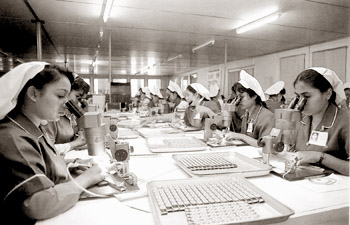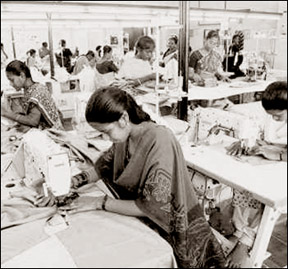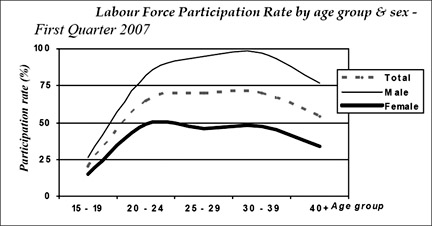Towards an inclusive development policy
Women in Development:
by Indeewara Thilakarathne
 It is, by now, a universally acknowledged fact that development is
not possible without the participation of women. Womens contribution to
the economy both informal and formal sectors are multiple as they play
diverse roles as mothers, workers. It is, by now, a universally acknowledged fact that development is
not possible without the participation of women. Womens contribution to
the economy both informal and formal sectors are multiple as they play
diverse roles as mothers, workers.
In Sri Lankan context, womens involvement in the development process
is still minimal compared with other countries. Out of 225 seats in
parliament, women parliamentarians occupy only 11 seats accounting for
less than five percent in representation. Womens participation at
provincial level is less than two percent.
According to Quarterly statistical review by the Department of Census
and Statistics, womens participation in labour force is 33.2 per cent
compared with their male counterparts participation accounted for 68.1
per cent indicating serious demographic gap between male and female
participation in labour force.
The survey findings also revealed that the estimated economically
active population (or labour force) was about 7.5 million in the first
quarter 2007 and of the economically inactive population 30 percent were
male and 70 per cent were females.
Considering the structure of employment sector wise, 65 per cent of
employed persons are in the informal sector with agriculture accounting
for 85 per cent of the informal sector while 41 per cent engaged in
service sector.
 The total number of employed persons in Sri Lanka is estimated to be
about 7.0 million. Even among the employed women, it has been estimated
that 5.2 per cent women are under employed. The total number of employed persons in Sri Lanka is estimated to be
about 7.0 million. Even among the employed women, it has been estimated
that 5.2 per cent women are under employed.
Among the unemployed women, women above the age of 30 accounted for
3.9 per cent compared to 1.4 per cent in the male category. Unemployment
is acute among GCE (A/L) qualified women more than men in the educated
category accounting for 12.3 per cent and 7 per cent and 18 per cent for
male and female respectively.
Womens involvement in diverse sectors namely agriculture, industrial
and service, are relatively lower than mens in the same sectors.
For instance, in the service sector 71 per cent of employed persons
are male with female accounted only for 28.3 per cent and large numbers
of women are employed in agricultural sector accounting for 41 per cent
of the total employment.
Reforms in overall development policy
 It is imperative if Sri Lanka really wanted to achieve millennium
development goals, the present development policy has to be reformed and
re-designed, encouraging women participation in the sphere of
development. It is imperative if Sri Lanka really wanted to achieve millennium
development goals, the present development policy has to be reformed and
re-designed, encouraging women participation in the sphere of
development.
However, given the high level of literacy rate and level of education
on the part of women in Sri Lanka, quota system would not be appropriate
as it could be counter productive. It should be a development policy
which is inclusive and assimilates women in diverse sectors into the
mainstream economy and production process.
Radical reforms should be brought about in the spheres of education,
employment and the recruitment policy in both Government and private
sectors.
[email protected]
****
Global position:
Economic decision-making facts and figures
Only 1% of the world's assets are in the name of women.
Men in the Arab states have 3.5 times the purchasing power of their
female counterparts.
70% of people in abject poverty living on less than $1 per day are
women. Among the developed countries, in France only 9% of the workforce
and in the Netherlands 20% of the workforce are female administrators
and managers.
Among the developing countries, in Ecuador and the Bahamas, 33% of
the workforce is comprised of women administrators and managers.
Women's participation in managerial and administrative posts is
around 33% in the developed world, l5% in Africa, and 13% in Asia and
the Pacific. In Africa and Asia-Pacific these percentages, small as they
are, reflect a doubling of numbers in the last twenty years.
Seventy percent of the 1.3 billion people living in poverty around
the world are women and children.
Two-thirds of the 876 million illiterate adults worldwide are women.
Two-thirds of the 125 million school-aged children who do not attend
school worldwide are girls, and girls are less likely to complete school
than boys.
More than three-quarters of the world>s 27 million refugees are women
and children. Every Day 1,600 women die needlessly during pregnancy and
childbirth There are only 5 women chief executives in the Fortune 500
corporations, Governing the most valuable publicly owned companies in
the United States.
These include the CEOs of Xerox, Spherion, Hewlett-Packard, Golden
West Financial, and Avon Products.
In Silicon Valley, for every 100 shares of stock options owned by a
man, only one share is owned by a woman. |
